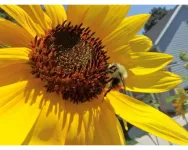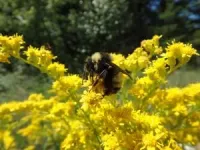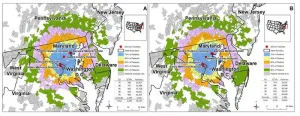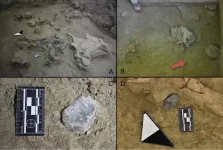(Press-News.org) TORONTO, May 22, 2024 – Community science volunteers – laypeople with an interest in bees and conservation – significantly contribute to the scientific knowledge of native bumble bees across Canada and the United States, finds a new study by York University.
It’s buzz worthy confirmation that community science programs can play an important role in monitoring the changing distributions of bumble bees and more. Community scientists have importantly also detected several at-risk or endangered species in unexpected locations, including the rusty-patched bumble bee and the gypsy cuckoo bumble bee. Trained scientists often haven’t seen some of the bees in years and these sightings can help them keep tabs on the species.
The paper, Bumble Bee Watch community science program increase scientific understanding of an important pollinator group across Canada and the USA, was published today in the journal PLOS ONE.
Up to a third of North American bumble bees are in decline, but the why of it is still fuzzy. Knowledge gaps about bumble bee stressors, ranges, population dynamics and preferred plants are prevalent.
“As scientists we really value the contribution of community scientists and the breadth of data they are able to gather, including a wide range of locations and species. As scientists usually lack the resources and time to do this kind of field work over such a large geographic area, it really shines a spotlight on the importance of community science programs,” says lead and corresponding author Victoria MacPhail, who conducted the research as part of her PhD at York’s Faculty of Environmental and Urban Change (EUC).
Through the growing Bumble Bee Watch (BBW) program, community scientists have been the eyes on the ground for bee researchers. The volunteers have taken photos of bumble bees from every province, state and territory and upload them through the BBW website along with where they were spotted and plant information if known. Bee taxon experts verify the species of bee.
“The data collected by volunteers through Bumble Bee Watch was surprisingly more plentiful, robust and valuable than anticipated and we rely on that data to add to our current knowledge and to confirm other information,” says MacPhail, who is also a former Bee Ecology, Evolution and Conservation coordinator at York.
MacPhail completed the study along with York Associate Professor Sheila Colla of EUC and Senior Endangered Species Conservation Biologist Richard Hatfield of the Xerces Society for Invertebrate Conservation in the United States. They compared BBW data collected by community scientists with the Bumble Bees of North America (BBNA), data collected through traditional scientific methods, for all years available and specifically from 2010 to 2020.
The researchers found the BBW covered as much ground geographically, as the BBNA over all years – 63 provinces, states and territories – and had information on 41 species compared to 48 in the BBNA.
Looking exclusively at the decade from 2010 to 2020, the BBW had data from an additional four provinces and states, and more information about 13 species than in the BBNA.
In terms of percentages, the BBW contributed 8.5 per cent of overall records, but that increased to more than 25 per cent during the specific decade being studied. Community scientists were able to confirm the prevalence of species as well as inform researchers of which species were inhabiting new locations.
They also contributed ecological information, such as species data for most of the bee species and unique plant genera. Knowing which flowers different types of bumble bees prefer is nothing to sneeze at as it can help prevent habitat loss and inform conservation management.
“While the BBW had fewer bee records than the BBNA database overall, it definitely helps to fill in data gaps and provide new information, and it complements traditional scientific methods,” says Colla. “We found the BBW to be valuable as it bolsters our knowledge about habitat, species associations, distribution, and changes in population size, which helps to inform conservation management for bumble bees.”
In addition, community science programs can bring awareness to the threats facing bumble bees and help mitigate species decline as they are already interested, engaged and documenting bees, their habitats and their locations – buzz pollinating action and ideas.
###
York University is a modern, multi-campus, urban university located in Toronto, Ontario. Backed by a diverse group of students, faculty, staff, alumni and partners, we bring a uniquely global perspective to help solve societal challenges, drive positive change and prepare our students for success. York's fully bilingual Glendon Campus is home to Southern Ontario's Centre of Excellence for French Language and Bilingual Postsecondary Education. York’s campuses in Costa Rica and India offer students exceptional transnational learning opportunities and innovative programs. Together, we can make things right for our communities, our planet, and our future.
Media Contact:
Sandra McLean, York University Media Relations, sandramc@yorku.ca
END
Location, race and insurance status play a significant part in the odds of a patient being diagnosed with early-stage or late-stage cancer, according to a detailed medical records analysis of more than 94,000 patients with cancer by researchers at the Johns Hopkins Bloomberg School of Public Health and the Johns Hopkins Kimmel Cancer Center.
Patients who lived farther away from a facility designated a comprehensive cancer center (CCC) by the National Cancer Institute (NCI) and who received only a diagnosis or only treatment at the center had higher than average odds of a late-stage diagnosis, ...
Surgery involving sentinel lymph node biopsy for middle-aged women with estrogen receptor-positive (ER+) breast cancer may do more harm than good, according to a new study led by University of Pittsburgh and UPMC Hillman Cancer Center researchers. The team used a novel artificial intelligence pipeline developed by Realyze Intelligence, a UPMC Enterprises portfolio company, to analyze electronic health records.
The findings, published today in JCO Clinical Cancer Informatics, suggest that clinical guidelines for de-escalating surgery in women aged over 70 years with early-stage ER+ breast cancer may be safely ...
MINNEAPOLIS – People who eat more ultra-processed foods like soft drinks, chips and cookies may have a higher risk of having memory and thinking problems and having a stroke than those who eat fewer processed foods, according to a new study published in the May 22, 2024, online issue of Neurology®, the medical journal of the American Academy of Neurology. The study does not prove that eating ultra-processed foods causes memory and thinking problems and stroke. It only shows an association.
Ultra-processed foods are high in added sugar, fat and salt, and low in protein and fiber. They include soft drinks, salty and sugary snacks, ...
MINNEAPOLIS – What factors lead older adults to stop driving? A new study followed older adults who had no memory or thinking problems to examine this question. The study is published in the May 22, 2024, online issue of Neurology®, the medical journal of the American Academy of Neurology.
“Alzheimer’s disease develops over a long time—people may have a 10- to 15-year period where they have no symptoms, but the disease process is developing in the brain,” said study author Ganesh M. Babulal, PhD, OTD, of Washington University School of Medicine in St. ...
One of the thorniest decisions facing older adults is when to give up their keys and stop driving. A new study by researchers at Washington University School of Medicine in St. Louis could provide guidance in helping seniors plan ahead. The researchers found that impaired cognitive function foreshadows the decision for many seniors to stop driving — more so than age or molecular signs of Alzheimer’s disease. Even very slight cognitive changes are a sign that retirement from driving is imminent. Further, women are more likely to stop driving than ...
May 22, 2024 – Irina Petrache, MD, ATSF, today added president of the American Thoracic Society to her list of accomplishments. The announcement came on the heels of the Plenary Session at the ATS 2024 International Conference. The slate of officers to serve on the Society’s Executive Committee for the 2024-2025 term consists of the following:
Irina Petrache, MD, ATSF, Incoming President
Dr. Petrache is professor of medicine at National Jewish Health and at the University of Colorado. She also serves as chief of Pulmonary, Critical Care and Sleep Medicine, associate ...
Contact: Nina Raffio, raffio@usc.edu or (213) 442-8464
Rising sea levels and urban development are accelerating coastal erosion at an alarming rate in Southern California with significant ripple effects on the region’s economy, a USC study reveals.
The study, published in Communications Earth & Environment, predicts that Southern California’s coastal living costs will surge fivefold by 2050 as a direct result of beach erosion. This erosion will require more frequent and costly beach nourishment projects to maintain the state’s treasured shorelines, consequently driving up the cost of living along the coast.
“Our ...
World renowned pulmonologists and experts in respiratory medicine from the Mount Sinai Health System in New York City will present new research at the American Thoracic Society (ATS) 2024 International Conference in San Diego from May 17–May 22. Please let me know if you would like to coordinate an interview about their work. Mount Sinai doctors and researchers are also available to comment on breaking news and trending topics.
Sessions and Symposiums
(All abstracts listed below are under embargo until the scheduled start ...
Thousands of years ago, early hunter-gatherers returned regularly to Tagua Tagua Lake in Chile to hunt ancient elephants and take advantage of other local resources, according to a study published May 22, 2024 in the open-access journal PLOS ONE by Rafael Labarca of the Pontifical Catholic University of Chile and colleagues.
Multiple archaeological sites are known from the region of Tagua Tagua Lake in central Chile, representing some of the earliest known human settlements in the Americas. In this study, Labarca and colleagues report ...
Twitter may be overlooking misinformation "superspreaders" - political pundits, low-credibility media outlets, and influencers who use more toxic language than the typical misinformation spreader
###
Article URL: https://journals.plos.org/plosone/article?id=10.1371/journal.pone.0302201
Article Title: Identifying and characterizing superspreaders of low-credibility content on Twitter
Author Countries: USA, UK
Funding: This work was supported by the John S. and James L. Knight Foundation, Craig Newmark Philanthropies, and the National Science Foundation (grant ACI-1548562). The funders had no role in study design, data ...






